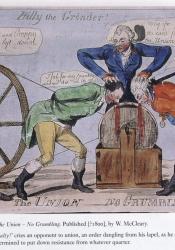Acts of Union 1800
In chapter 23 of Jane Eyre, Mr. Rochester divulges to Jane that she is to be sent off to Bitternut Lodge in Ireland to become a governess to a new family. Jane immediately expresses discontentment towards the idea of being forced to relocate, especially due to the distance between her current residence at Thornfield and her new home-to-be in Ireland. The relationship between England and Ireland is rocky at best, no doubt due to the centuries old conflict dating back to the 12th century. It wasn’t until the Acts of Union in 1800 in which the parliaments of both Great Britain and Ireland joined to create the United Kingdom of Great Britain and Ireland. Published in a book on the relationships of the U.K. titled Four Nations Approaches to Modern ‘British’ History, author and scholar James Stafford writes “Straddling the eighteenth and nineteenth centuries, and positioned between the fields of British and Irish history, the Union of Britain and Ireland can be seen, according to J.G.A. Pocock, as ‘the hinge … marking the transition from early modern to modern “British history”.’ 1 This usefully highlights both its importance, and its elusiveness” (Stafford). In this excerpt, Stafford alludes to the extreme importance the acts had on the two converging nations as the government's attempt to smooth over the rocky history. As the acts were constructed around a similar time as the novel, Brontë demands the reader utilize contemporary knowledge as they ponder the (albeit brief) moments in which Jane imagines a life outside Thornfield, thrusted into a life of political unrest. This unrest suits Jane’s reaction to the move, working in accordance to her emotional state of not wanting to leave her future lover.
Stafford, J. (2018). “The Scottish Enlightenment and the British-Irish Union of 1801” In: Lloyd-Jones, N., Scull, M. (eds) Four Nations Approaches to Modern 'British' History. Palgrave Macmillan, London. https://doi.org/10.1057/978-1-137-60142-1_5
The Union- No Grumbling. Published 1800, by W. McCleary

